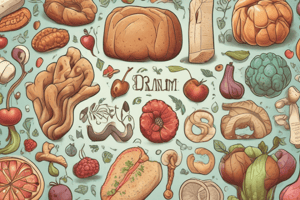Podcast
Questions and Answers
What type of bonds are present in starch molecules?
What type of bonds are present in starch molecules?
- β-1,4 linkages
- α-1,4 and α-1,6 linkages (correct)
- α-1,4 and β-1,6 linkages
- β-1,6 linkages
What is the main difference between gums and mucilages?
What is the main difference between gums and mucilages?
- Gums are sulphuric acid esters, while mucilages are composed of Ca, K, and Mg salts
- Gums are composed of Ca, K, and Mg salts, while mucilages are sulphuric acid esters (correct)
- Gums are composed of polysaccharides, while mucilages are composed of polyuronides
- Gums are composed of polyuronides, while mucilages are composed of polysaccharides
What is the result of hydrolyzing a polysaccharide?
What is the result of hydrolyzing a polysaccharide?
- A definite number of monosaccharides
- Only glucose molecules
- An indefinite number of monosaccharides (correct)
- A mixture of sugars and uronic acids
What is the type of linkage present in cellulose molecules?
What is the type of linkage present in cellulose molecules?
What is the common name for the polysaccharide found in animals?
What is the common name for the polysaccharide found in animals?
Flashcards are hidden until you start studying
Study Notes
Polysaccharides
- Hydrolysis of polysaccharides produces an indefinite number of monosaccharide molecules called glycans.
Biologically Significant Polysaccharides
- Starch: a common polysaccharide of biological significance
- Glycogen (Animal starch): a common polysaccharide of biological significance
- Cellulose: a common polysaccharide of biological significance
- Inulin: a common polysaccharide of biological significance
Structure of Starch and Cellulose
- Starch: glucose units joined by α-1,4 and α-1,6 linkages
- Cellulose: glucose units joined by β-1,4 linkages
Derivatives of Polysaccharides
- Gums: consist of Ca, K, and Mg salts of complex substances called polyuronides
- Properties of Gums: on prolonged boiling with dilute acids, they yield sugar and uronic acids
- Mucilages: sulphuric acid esters
Studying That Suits You
Use AI to generate personalized quizzes and flashcards to suit your learning preferences.




